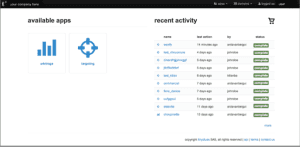
Sometimes you meet people in amazing situations! I used to look at the list of new subscribers to the Badsender newsletter every day, to check their profiles on LinkedIn and eventually get in touch with them. That's how I sent an email to Ardavan Beigui and a week later I found myself in the offices of tinyclues in Paris, coffee in hand, discussing their solution.
A path between sales and data

Before talking about tinyclues, let's first get to know our interviewee! After studying at ESCP Paris, Ardavan had fun for a few years (from 2000 to 2007) commuting between France and the United States. His job? Sales manager in the publishing industry! After 7 years in this position, he found himself in a completely different position at Come&Stay (from 2007 to 2011) as head of lead collection products and then director until he left for Adsenzia in 2011 where he became general manager.
Ardavan then decided to take a step back and left Adsenzia in early 2013. He got back in touch with David Bessis whom he had known for years, and with whom he had sworn to work again one day. A few months later, in the summer of 2013, Ardavan became "Head of Client Operations" at tinyclues.
Where does tinyclues come from?
tinyclues is first and foremost the project of one person, David Bessis. After a career as a mathematics researcher, David made a foray into the field of online marketing, where he had the opportunity to study the various segmentation and scoring approaches used in the field. What he saw did not really convince him, the segmentation approaches used were at best inadequate... and often totally wrong mathematically.
In 2010, he founded tinyclues with Jakob Haesler, former Partner at McKinsey. Until 2013, tinyclues operates on its own funds. During these three years, they work on mathematical models to offer efficient scoring and segmentation methods. This research will lead to the launch of a predictive CRM platform in SaaS mode in early 2013. At the end of 2013, all these efforts are rewarded by a fundraising of 1.4 million euros from Isai, Elaia Partners and business angels.
Today, out of the 14 people who make up the tinyclues team, 11 are mathematicians and computer scientists. The team will soon grow as a number of recruitments are underway.
Predictive CRM: what makes tinyclues different?
The main difference of tinyclues is summarized in its name! The platform uses all the clues hidden in its clients' data to build prediction models. To give you an idea, the platform will be able to detect links, if they exist, between the purchase of peach items on an e-commerce site, the age of the buyer and the prediction of the purchase of a Johnny Halliday CD (this is obviously an example 😉 ). More generally, the tinyclues platform is able to find links between very small clues in its clients' data to predict the success of their CRM campaigns: a click in an email 3 months ago, a clue in the first name or postal code, a product seen on the client's site last week... So many clues that are often ignored by existing solutions.
The big difference between the tinyclues platform and what can be found in the Big Data and BI field is that the solution does not require any technical skills to be used. Whether it is at the configuration or operation level. During the implementation of a project, tinyclues will retrieve all the data available to its client, without the company having to categorize its data or do any data processing beforehand. Where data companies mainly offer visualization solutions or consulting services, tinyclues focuses on exploitation: facilitating targeting, personalization, arbitration, in a few clicks. Nothing else.
And from an operational point of view, what does this mean?
Need help?
Reading content isn't everything. The best way is to talk to us.
Let's finally get to the heart of the matter! With customers like Priceminister, Cdiscount or France Billet, tinyclues has managed to attract big names around its solution. And it's not by chance.

The tinyclues platform offers many apps, two of which answer many of the real-world questions of its customers. Here they are:.
- targeting: this app allows you to choose a product in your catalog and to calculate a liking score for each consumer in your database. This will allow you to choose the desired volume of addresses and you are assured of obtaining a target with the highest probability of buying your product.
- arbitration: this feature allows you to select several products from your catalog. According to the selected products, the platform will automatically build as many targets. This system allows you to create a sort of "dynamic segmentation" based not on the marketer's assumptions (on gender, age, or CSP), but on all the data present in the advertiser's database.
A/B tests conducted by tinyclues clients have shown an increase from 30% to 40% in revenue generated by campaigns targeted via the platform, while generating 1/3 less unsubscribes, compared to the solutions in place at clients.
As you can see, tinyclues offers a different but extremely powerful approach to help you deliver the right message to your customers.
What are the projects for the future?
Today, tinyclues' platform is used for CRM push for its clients (emailling, Facebook Custom Audience, mobile push). They are working on expanding the set of functionalities, notably by integrating real time issues - to be followed with announcements to come during the year!
What I thought of it!
I must admit that I was surprised by the proposed solution. I was expecting a much more complex platform. When we talk about Big Data, predictive, we expect to have hundreds of dashboards filled with data. This is not the case here.
Is this a problem? Quite the opposite. With easy-to-use features, the marketer can really focus on the essentials, craft a powerful message and send it to a target audience interested in the product. When I tell you that there is no dashboard, it is not quite true. When you use the "targeting" app for example, you can see the socio-demographic profile of consumers interested in the product (and vary this profile according to the appetence score). The relevant reports are of course available on the platform.
Routing continues to be done via your existing solution, to which the tinyclues platform exports the built segments in real time.
Finally, a platform that tries to simplify the life of the marketer while offering a fast, powerful solution without empty promises.
Leave a Reply